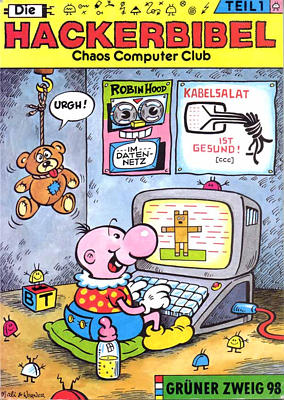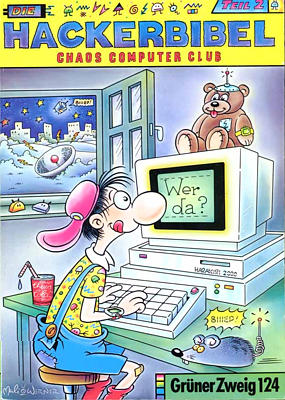Julia Schramm: Klick mich: Bekenntnisse einer Internet-Exhibitionistin (2012) [German]
Filed under book | Tags: · biography, blogging, germany, internet, pirate party, politics

Politologin, Publizistin, Piratin, Provokateurin, Privilegienmuschi, Post-Gender-Feministin, Politikerin.
Sie leben im Netz. Sie kommen aus dem Netz. Sie kennen die echte Welt und haben noch eine Welt hinter dem Monitor, mit allen Geschichten, allen Bildern, allem Wissen der Menschheit. Von dort aus erobern sie die Wirklichkeit. Die Kinder des digitalen Zeitalters sitzen mittlerweile in den Parlamenten und stehen mächtigen Firmen vor. Wir müssen sie kennenlernen. Julia Schramm – die, die aus dem Internet kommt – erzählt ihre Geschichte. Was sie macht. Wie sie lebt. Wie sie denkt.
»Mein Name ist Julia und ich lebe im Internet. Ich bin da ziemlich glücklich, habe Freunde, die ich nur digital kenne und abschalten kann, wann ich will. Ich kann im Internet alles sein: Mafiaboss, Barbie, Hitler, Hotelbesitzer und ein kleines grünes Krokodil. Am Computer bin ich Gott. Und dabei fühle ich mich großartig – großartig böse, kalt und berechnend. Bereits in jungen Jahren, mit 13 oder 14, war ich mir über die schier endlosen Möglichkeiten der Identitätskonstruktion bewusst. Das Internet war der Ort, wo ich alles zum ersten Mal erlebte: Liebe, Sex und Verrat. Aufklärung, Freiheit und Politik. Dort rede, lache, weine und denke ich. Denn ich bin ein Kind des digitalen Zeitalters, ich bin die, die aus dem Internet kommt. Und das ist meine Geschichte.«
Publisher Albrecht Knaus, Muenchen, Random House, 2012
ISBN 3641081920, 9783641081928
208 pages
FAIL – Prominent Pirate Party Politician Goes After Book Pirates (Torrentfreak)
Pirate Party Member Insists on Copyright for Book (Spiegel)
author
wikipedia
publisher
google books
Timothy Lenoir (ed.): Inscribing Science: Scientific Texts and the Materiality of Communication (1998)
Filed under book | Tags: · cartography, communication, germany, history of science, information, materiality, photography, science, semiotics, technology

Early practitioners of the social studies of science turned their attention away from questions of institutionalization, which had tended to emphasize macrolevel explanations, and attended instead to microstudies of laboratory practice. Though sympathetic to this approach—as the microstudies included in this book attest—the author is interested in re-investigating certain aspects of institution formation, notably the formation of scientific, medical, and engineering disciplines. He emphasizes the manner in which science as cultural practice is imbricated with other forms of social, political, and even aesthetic practices.
This book offers case studies that reexamine certain critical junctures in the traditional historical picture of the evolution of the role of the scientist in modern Western society. It focuses especially on the establishment of new disciplines within German research universities in the nineteenth century, the problematic relationship that emerged between science, industry, and the state at the turn of the twentieth century, and post-World War II developments in science and technology.
After an Introduction and two chapters dealing with science and technology as cultural production and the struggles of disciplines to achieve legitimation and authority, the author considers the following topics: the organic physics of 1847; the innovative research program of Carl Ludwig as a model for institutionalizing science-based medicine; optics, painting, and ideology in Germany, 1845-95; Paul Ehrlich’s “magic bullet”; the Haber-Bosch synthesis of ammonia; and the introduction of nuclear magnetic resonance instrumentation into the practice of organic chemistry.
Publisher Stanford University Press, 1998
Writing Science series
ISBN 0804727775, 9780804727778
476 pages
Chaos Computer Club (ed.): Die Hackerbibel, 1-2 (1985, 1988) [German]
Filed under book | Tags: · computing, germany, hacker culture, hacking, history of computing, history of technology, internet, machine, networks, privacy, programming, radio, security, technology, telephone, video


“Die Hackerbibel ist eine Publikation des Chaos Computer Clubs. Sie ist bisher in zwei Ausgaben in den Jahren 1985 und 1988 erschienen. Beide Ausgaben wurden von Wau Holland herausgegeben und vom Verlag Grüne Kraft veröffentlicht.
Die Hackerbibel ist ein Sammelsurium aus Dokumenten und Geschichten der Hacker-Szene, wie beispielsweise die Bauanleitung für den als „Datenklo“ betitelten Akustikkoppler. Sie bietet darüber hinaus Bauanleitungen und andere technische Hintergründe. Die 1. Ausgabe erschien 1985 mit dem Untertitel Kabelsalat ist gesund, und erzielte bis Mitte 1988 eine verkaufte Auflage von 25.000 Exemplaren. Die Ausgabe 2 aus dem Jahr 1988 wird auch Das neue Testament genannt. Die Comic-Zeichnungen der Umschlagbilder sind eine Schöpfung der deutschen Comic-Zeichner Mali Beinhorn und Werner Büsch von der Comicwerkstatt Büsch-Beinhorn. Die Produktion und der Vertrieb der Hackerbibel wurde schon vor 1990 eingestellt. Seit 1999 bietet der CCC eine gescannte und im Volltext verfügbare Version mit weiterem Material, wie Texte von Peter Glaser, eine Dokumentation zu Karl Koch und die Arbeiten von Tron, auf der Chaos-CD an.” (wikipedia)
Die Hackerbibel Teil 1. Kabelsalat ist gesund, Grünen Kraft, Löhrbach, ISBN 3922708986, 260 Seiten
Die Hackerbibel Teil 2. Das neue Testament, Grünen Kraft, Löhrbach, ISBN 3925817247, 260 Seiten
PDF (Teil 1, 56 MB, no OCR, updated on 2024-2-3)
HTML (Teil 1, updated on 2024-2-3)
PDF (Teil 2, 43 MB, no OCR, updated on 2024-2-3)
HTML (Teil 2, updated on 2024-2-3)

